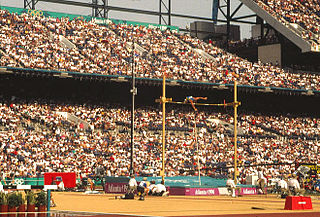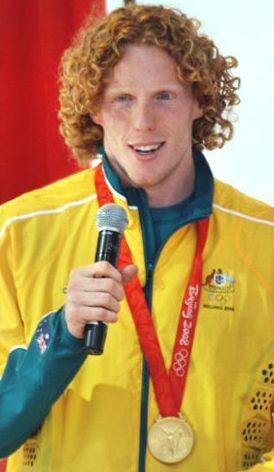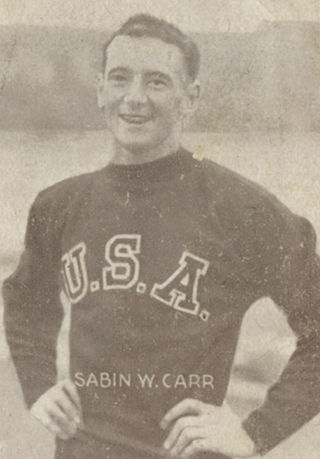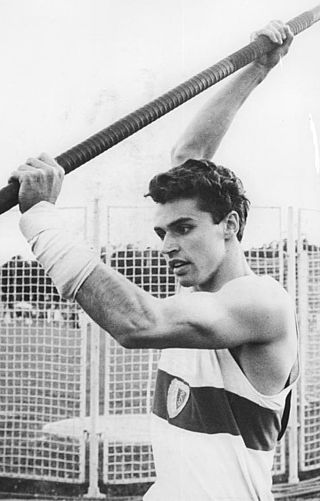
The men's pole vault was one of four men's jumping events on the Athletics at the 1964 Summer Olympics program in Tokyo. Qualification was held on 15 October 1964, with the final on 17 October. 32 athletes from 20 nations entered, with 2 not starting in the qualification round. The final lasted over seven hours, to date the longest competition in history. All finalists qualified at 4.60, however in the final five were unable to achieve the height again.
The men's pole vault at the 1988 Summer Olympics in Seoul, South Korea had an entry list of 21 competitors from 13 nations, with two qualifying groups before the final (15) took place on Wednesday September 28, 1988. The maximum number of athletes per nation had been set at 3 since the 1930 Olympic Congress.
The men's pole vault was a track and field athletics event held as part of the Athletics at the 1912 Summer Olympics programme. It was the fifth appearance of the event, which is one of 12 to have been held at every Summer Olympics. The competition was held on Wednesday, July 10, 1912, and on Thursday, July 11, 1912. Twenty-five pole vaulters from eleven nations competed. NOCs could enter up to 12 athletes. It was the second straight Games in which more than 3 medals were awarded in the event. The event was won by Harry Babcock of the United States, the nation's fifth consecutive victory in the event. Fellow Americans Frank Nelson and Marc Wright tied for second and were both awarded silver; normally, this would have constituted a medal sweep. However, bronze medals were awarded to the three men tied for fourth place. This put both Canada and Sweden on the podium for the second consecutive Games and awarded the United States a total of four medals in the 1912 pole vault.

The men's pole vault was an event at the 1956 Summer Olympics in Melbourne, Australia. Nineteen athletes from 12 nations competed. The maximum number of athletes per nation had been set at 3 since the 1930 Olympic Congress. The final was held on the third day of the track and field competition, on Monday November 26, 1956. The event was won by Bob Richards of the United States, the nation's 13th consecutive victory in the event. Richards was the first man to successfully defend Olympic gold in the pole vault; he was also the first man to win three total medals in the event. For the second straight Games, the American team went 1–2, this time with Bob Gutowski taking silver. Georgios Roubanis's bronze was Greece's first pole vault medal since 1896, and Greece's first Olympic medal overall since 1920.

The men's pole vault was an event at the 1996 Summer Olympics in Atlanta, Georgia. Thirty-seven athletes from 24 nations competed. The maximum number of athletes per nation had been set at 3 since the 1930 Olympic Congress. The event was won by Jean Galfione of France, the nation's second victory in the event. Igor Trandenkov took silver, the first medal for Russia in the pole vault in its first appearance as a separate delegation. Similarly, Andrei Tivontchik's bronze was the first for reunified Germany, though both East Germany and West Germany as well as the Unified Team of Germany had previously won medals.

The men's pole vault was an event at the 1952 Summer Olympics in Helsinki, Finland. Twenty-eight athletes from 18 nations competed. The maximum number of athletes per nation had been set at 3 since the 1930 Olympic Congress. The final was held on Tuesday July 22, 1952. The event was won by Bob Richards of the United States, the nation's 12th consecutive victory in the men's pole vault. Another American, Don Laz, took silver. Ragnar Lundberg's bronze was Sweden's first medal in the event since 1912.

The men's pole vault event was part of the track and field athletics programme at the 1920 Summer Olympics. The competition was held on Wednesday, August 18, 1920, and on Friday, August 20, 1920. 16 pole vaulters from seven nations competed. No nation had more than 4 jumpers, suggesting the limit had been reduced from the 12 maximum in force in 1908 and 1912. The event was won by Frank Foss of the United States, the nation's sixth consecutive victory in the men's pole vault. Henry Petersen's silver was Denmark's first medal in the event and the first time a non-American had done better than bronze in the pole vault. Edwin Myers's bronze continued the American streak of winning at least two medals in each pole vault, however.

The men's pole vault was an event at the 1992 Summer Olympics in Barcelona, Spain. There were a total number of 34 participating athletes from 23 nations. The maximum number of athletes per nation had been set at 3 since the 1930 Olympic Congress. The qualification mark was set at 5.60 metres.

The men's pole vault event at the 1984 Summer Olympics in Los Angeles, California had an entry list of 19 competitors from 13 nations, with two qualifying groups before the final (12) took place on Wednesday August 8, 1984. The maximum number of athletes per nation had been set at 3 since the 1930 Olympic Congress. The event was won by Pierre Quinon of France, the nation's first medal in the men's pole vault. France also took one of the two bronze medals after Thierry Vigneron tied with Earl Bell of the United States for third. Mike Tully, also American, earned silver. Bell and Tully continued the American streak of podium appearances in the event every time the United States competed.

The men's pole vault at the 2008 Summer Olympics took place on 20 and 22 August at the Beijing National Stadium. Thirty-eight athletes from 25 nations competed. The event was won by Steven Hooker of Australia, the nation's first medal in the men's pole vault. Russia took its third medal of the four Games since competing independently; including Russian vaulters for the Soviet Union and Unified Team, Russians had taken six medals in the last six Games. The bronze medal initially went to Denys Yurchenko of Ukraine, but was later stripped from him for doping offenses and reassigned to fourth-place finisher Derek Miles of the United States.

The men's high jump at the 2008 Olympic Games took place on 17–19 August at the Beijing Olympic Stadium. Forty athletes from 28 nations competed. The event was won by Andrey Silnov of Russia, the nation's second victory in the men's high jump. Germaine Mason's silver was Great Britain's first medal in the event since 1996, and matched the nation's best-ever result. Silnov's countryman Yaroslav Rybakov won bronze, marking the first time since 1988 that a nation had two medalists in the men's high jump in the same Games. Reigning world champion Donald Thomas, who cleared 2.32 metres at Osaka 2007, finished in twenty-first place and failed to advance into the final round. For the first time, no American made the final.

The men's pole vault event at the 1980 Summer Olympics in Moscow, Soviet Union had an entry list of 19 competitors from 10 nations. The maximum number of athletes per nation had been set at 3 since the 1930 Olympic Congress. The final was held on Wednesday July 30, 1980. The top twelve and ties and all those clearing 5.40 metres advanced to the final. The event was won by Władysław Kozakiewicz of Poland, the nation's second consecutive victory in the men's pole vault. His countryman Tadeusz Ślusarski, who had won the event four years earlier, became the fifth man to earn two medals in the event when he finished in a tie for silver. The other silver went to Konstantin Volkov and was the Soviet Union's first pole vault medal.

The men's pole vault event at the 2000 Summer Olympics as part of the athletics program was held at the Olympic Stadium on Wednesday, 27 September, and Friday, 29 September. Thirty-six athletes from 22 nations competed. The maximum number of athletes per nation had been set at 3 since the 1930 Olympic Congress. The event was won by Nick Hysong of the United States, the nation's first victory in the event since its 16-Games streak ended. The American team also took silver, as Lawrence Johnson finished second. Russia's Maksim Tarasov became the seventh man to win multiple pole vault medals, and the second to do so under two different flags, adding a bronze to his 1992 gold.

The men's pole vault event at the 1928 Olympic Games took place on August 1. Twenty athletes from thirteen nations competed. The maximum number of athletes per nation was four. The event was won by Sabin Carr of the United States, for the nation's eighth consecutive victory in the men's pole vault. Americans William Droegemuller and Charles McGinnis won silver and bronze respectively, giving Team USA their second consecutive and third overall medal sweep in the Olympic pole vault event.

The men's pole vault event was part of the track and field athletics programme at the 1936 Summer Olympics. The competition was held on August 5, 1936. Thirty athletes from 21 nations competed. The maximum number of athletes per nation had been set at 3 since the 1930 Olympic Congress. The final was won by Earle Meadows of the United States. It was the nation's tenth consecutive victory in the men's pole vault.

The men's pole vault event was part of the track and field athletics programme at the 1948 Summer Olympics. Nineteen athletes from 10 nations competed. The maximum number of athletes per nation had been set at 3 since the 1930 Olympic Congress. The competition was held on July 31 and August 2. During the final, a rainstorm came in during the jumps at 4.10. All the jumpers at 4.20 and higher had to deal with wet conditions on the runway and with their poles. The final was won by American Guinn Smith. Erkki Kataja had held the lead with a perfect set of jumps until Smith's last attempt clearance of 4.30. Smith's win was the United States' 11th consecutive victory in the men's pole vault. Kataja's silver was Finland's first medal in the event.

The men's pole vault field event at the 1972 Olympic Games took place on September 1 & 2. Twenty-one athletes from 12 nations competed. The maximum number of athletes per nation had been set at 3 since the 1930 Olympic Congress. The event was won by Wolfgang Nordwig of East Germany, the first non-American to win the event. Nordwig and silver medalist Bob Seagren were the third and fourth men to win multiple medals in the event.

The men's pole vault competition featured in the athletics programme at the 1976 Summer Olympics and was held at the Olympic Stadium in Montréal on 24 and 26 July. Twenty-seven athletes from 13 nations competed. The maximum number of athletes per nation had been set at 3 since the 1930 Olympic Congress.

The men's pole vault was one of four men's jumping events on the athletics program at the 1968 Summer Olympics. The competition had two rounds, qualifying and a final, which were held on 14 and 16 October respectively at the Estadio Olímpico Universitario in Mexico City. Twenty-three athletes from 15 nations competed. The maximum number of athletes per nation had been set at 3 since the 1930 Olympic Congress. The event was won by Bob Seagren of the United States, the nation's 16th consecutive victory in the men's pole vault. Claus Schiprowski of West Germany took silver, while Wolfgang Nordwig of East Germany took bronze—the first medals for each of those nations as separate teams, though two West German vaulters had earned silver and bronze for the United Team of Germany in 1964.

The men's pole vault event at the 2020 Summer Olympics took place between 31 July and 3 August 2021 at the Japan National Stadium. 29 athletes from 18 nations competed. Armand Duplantis of Sweden won gold, with Christopher Nilsen of the United States earning silver and Thiago Braz of Brazil taking bronze. It was Sweden's first victory in the event and first medal of any color in the men's pole vault since 1952. Braz, who had won in 2016, became the ninth man to earn multiple medals in the pole vault.

















